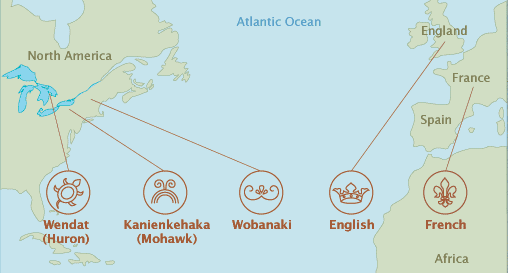|
Meet the Five Cultures
On February 29, 1704, an English settlement situated in Pocumtuck homelands in the mid-Connecticut River valley, became a crossroads for intercultural, interracial, and international conflict. The raid on Deerfield was one incident in an ongoing struggle among Europeans and northeastern Native communities competing for control of Native lands and resources in the colonial northeast. Algonkian and Iroquoian peoples; French, English, and Africans; soldiers, ministers, farmers and traders; men, women, and children—all were affected by these conflicts.
At least five cultural groups were present at the attack in 1704: English, French, Kanienkehaka (Mohawk), Wendat (Huron) and Wôbanaki (Abenaki, Pennacook, Sokoki, Pocumtuck and others).

Follow the links below to learn more about each group.
 |
English
The region to which the English immigrated and renamed New England had been carefully stewarded by Native peoples for millennia. English settlers, however, viewed these lands as a vacant wilderness to be possessed and subdued. The seemingly insatiable English desire for new lands where they could farm, raise families, and create an ideal Protestant society, generated conflict between these newcomers and the region's indigenous inhabitants. The land was further contested as imperial wars drove the English to fight the French for possession of the continent's rich resources.
Learn more about the English.
|
 |
French
France's growing colonial empire included New France on the North American continent. Until the early 18th century, the vast majority of French immigrants to New France were single men, rather than family groups. French goals included maintaining friendly and profitable trade relations with Native people, converting them to Roman Catholicism, and restraining English imperial ambitions.
Learn more about the French.
|
 |
Kanienkehaka (Mohawk)
The Kanienkehaka (Mohawk) members of the raiding party in 1704 came from the villages of Kahnawake, La Montagne, and Sault-au-Récollet (present-day Kanesatake), located on the northern edge of Kanienkeh, the Kanienkehaka homeland, near Montreal, Quebec. These people, members of the Rotinonsionni or the Five Nation Iroquois Confederacy, had moved north from the Mohawk River valley beginning in the 1660s.
Learn more about the Kanienkehaka.
|
 |
Wendat
(Huron)
The Wendat Confederacy's traditional
homelands,
called Wendake, lie near the Georgian Bay in Lake Huron. French
colonization introduced disease and intensified existing hostilities
between the Wendats and the Iroquois Confederacy to the south.
By the 1650s, this warfare forced the Wendats from their lands;
some settled in Lorette (later renamed Wendake), a village
outside of Quebec City. A small contingent of this group joined
their Native and French allies in the expedition to Deerfield
in 1704.
Learn more
about the Wendats.
|
 |
Wôbanaki (Abenaki, Pennacook, Sokoki, Pocumtuck and others)
Many of the Wôbanaki peoples participating
in the raid of 1704 came from Odanak (St. Francis), situated
on the St. Francis River, in Quebec. Others came from Pennacook,
Missisquoi, Cowass and other Wôbanaki communities across
present-day Vermont, New Hampshire, and Maine. In the late
1600s, these northern communities began absorbing Native refugees
from Woronoco, Nonotuck and Sokoki, who had been forced out
of their homelands in the middle Connecticut River valley.
Among those displaced peoples from many homelands
were the Pocumtuck, whose original homeland had been transformed
into the English settlement of Deerfield.
Learn more about the Wôbanakiak.
|
|
![]()
![]()
